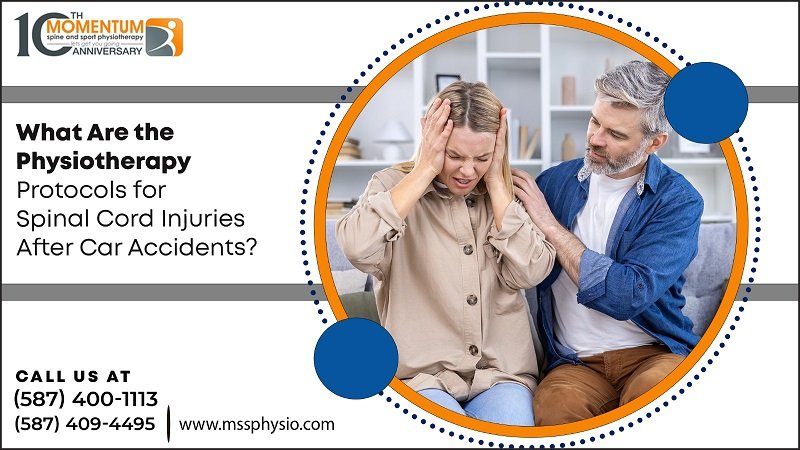Understanding the appropriate physiotherapy protocols for spinal cord injuries after car accidents is crucial for effective recovery. Spinal cord injuries will have profound and lasting impacts on an individual’s mobility and quality of life. Motor vehicle accident physiotherapy Windermere focuses on a tailored approach to help individuals regain strength, function, and independence. By employing specific techniques and exercises, physiotherapists aim to address the challenges faced by those recovering from such traumatic events.
Pain Management Techniques
1. Manual Therapy:
- Massage: Gentle pressure is applied to muscles to reduce tension. Techniques include kneading, circular motions, and light tapping.
- Mobilization: The therapist gently moves the joints through their range of movement to improve mobility and alleviate pain.
2. Modalities:
- Heat Therapy: Use a heating pad over the affected region for 15-20 minutes to increase blood flow and relax muscles.
- Cold Therapy: Use ice packs for 10-15 minutes to reduce inflammation and numb pain.
- Ultrasound Therapy: A device that delivers sound waves to deep tissues, promoting healing and pain relief.
- Electrical Stimulation: Low-level electrical currents are applied to the skin to reduce pain and stimulate healing.
Therapeutic Exercises
1. Strengthening Exercises:
- Isometric Exercises: These involve contracting muscles without movement, such as pressing the back against a wall. Maintain the contraction for 5-10 seconds, then release. Repeat 10-15 times.
- Resistance Training: Using weights or resistance bands, perform exercises like bicep curls, shoulder presses, and leg lifts. Start with light resistance, performing 2-3 sets of 10-15 repetitions each.
2. Flexibility and Range of Motion Exercises:
- Passive Range of Motion: A therapist moves the limbs through their range of motion, holding each position for 10-30 seconds. This helps maintain flexibility.
- Active Range of Motion: The individual moves their own limbs through their full range of motion, holding stretches for 10-30 seconds and repeating 3-5 times per session.
3. Endurance Training:
- Cardiovascular Exercises: Utilize a stationary bike or arm ergometer. Start with 5-10 minutes, gradually increasing to 20-30 minutes as endurance improves.
- Interval Training: Alternate between 1-2 minutes of high-intensity activity and 2-3 minutes of lower intensity. This improves cardiovascular fitness without overexertion.
Neuromuscular Re-education
1. Functional Electrical Stimulation (FES):
- Application: Electrodes are placed on the skin over specific muscles. Electrical currents are applied to stimulate contractions.
- Sessions: Perform sessions 3-5 times per week, starting with short durations and gradually increasing based on tolerance and progress.
2. Task-Specific Training:
- Daily Activities Practice: Engage in tasks such as transferring from a bed to a chair, grasping and releasing objects, or walking short distances.
- Repetition: Practice these tasks repeatedly to build muscle memory and improve functional abilities.
Balance and Coordination Training
1. Proprioceptive Training:
- Balance Boards: Stand or sit on a balance board, shifting weight to maintain balance. Start with 1-2 minutes, gradually increasing as stability improves.
- Foam Pads: Perform standing exercises on foam pads to challenge and improve balance and proprioception.
2. Balance Exercises:
- Single-Leg Stands: Stand on one leg, holding the position for 10-30 seconds. Use support if needed, gradually increasing the duration as balance improves.
- Heel-to-Toe Walking: Walk in a straight line. Place the heel of one foot directly in front of the other. Perform 10-15 steps, focusing on stability.
Gait Training
1. Treadmill Training:
- Assisted Walking: Use a harness and support system on a treadmill. Start with short sessions of 5-10 minutes, slowly increasing the duration as gait improves.
- Speed Variations: Adjust the treadmill speed to challenge and improve walking patterns.
2. Overground Walking:
- Parallel Bars: Practice walking between parallel bars for support. Focus on proper gait mechanics, gradually reducing reliance on the bars.
Adaptive Techniques and Assistive Devices
- Training on Wheelchairs: Patients receive instruction on how to properly use wheelchairs, including techniques for safe transfers, maneuvering in various environments, and maintaining the wheelchair.
- Braces and Orthotics: Training involves fitting and using braces or orthotics to support weakened muscles and improve mobility. This includes putting them on correctly and using them during daily activities.
- Assistive Devices: Guidance on using assistive devices such as walkers, crutches, and canes. This training focuses on optimizing their use to enhance mobility and independence.
Education and Support
Providing education on spinal cord injuries, recovery expectations, and ways to support the patient’s rehabilitation is essential. This includes educating both the patients and their families about the nature of spinal cord injuries, potential complications, and the rehabilitation process, setting realistic expectations for recovery, and teaching families how to support the patient’s rehabilitation. Educational sessions with the patient and family members, using visual aids and informational brochures, are conducted regularly, along with Q&A sessions to provide personalized advice and offer resources such as videos, handouts, and websites for ongoing learning.
Supporting patients involves providing access to counselling services to help them deal with the psychological impact of spinal cord injuries, facilitating support group meetings where individuals can share experiences as well as receive encouragement and teaching stress management techniques such as deep breathing, meditation, and relaxation exercises.
Motor vehicle accident physiotherapy in Windermere incorporates these methods to help patients regain strength, flexibility, endurance, and functional abilities, ultimately enhancing their quality of life.
Regain Mobility Through Physiotherapy
Momentum Physiotherapy provides comprehensive car accident physiotherapy structured to address the particular needs of patients recovering from spinal cord injuries. Adhering to well-established protocols ensures that each patient receives personalized care to improve their strength and overall quality of life.
If you or a loved one has been through a spinal cord injury due to a car accident, consider motor vehicle accident physiotherapy in Windermere for dedicated and effective treatment. Contact Momentum Physiotherapy today to start your journey toward recovery.


